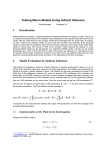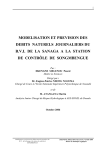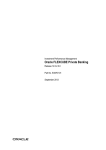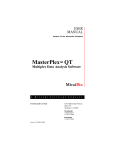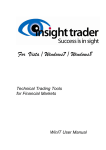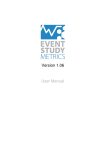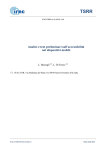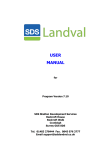Download Users` Manual for the Revision Spreadsheets
Transcript
User manual and pre-programmed spreadsheets for performing revision analysis This document describes how to perform revision analysis using pre-programmed template spreadsheets based on data extracted from the OECD Main Economic Indicators Original Release Data and Revisions Database. Such database contains original data as published in successive monthly editions of the Main Economic Indicators (MEI) CD-Rom from February 1999 for the following 21 key short-term economic statistics: • • • • • • • • • • • • • • • • • • • • • GDP total, constant prices; GDP Private consumption expenditure, constant prices; GDP Government consumption expenditure, constant prices; GDP Gross fixed capital formation, constant prices; GDP Exports of goods and services, constant prices; GDP Imports of goods and services, constant prices; GDP Total, current prices; GDP Total, implicit price deflator; Index of industrial production; Retail trade volume; Production in construction; Composite leading indicator, trend restored; Composite leading indicator, 6-month rate of change (annualised); Standardised unemployment rate; Civilian employment; Hourly earnings (manufacturing); Consumer price index; Monetary aggregates – broad money; International trade in goods – exports; International trade in goods – imports, and Balance of payments, current account balance. All pre-programmed template spreadsheets can be downloaded via the links included in this document, which describes in detail how to use the templates to perform revisions analysis with reference to an example based on the monthly index of industrial production for the United States. Please note, users must follow the instructions provided below precisely when performing a revisions analysis otherwise it is almost certain that errors will be made (i.e. don’t try and take short-cuts!). If users have their own source of historical vintage data this can also be used provided the data is formatted and treated as described below. 1 Revision triangles template The first step consists in importing data to the Revision triangles template, which can be accessed for monthly data at http://www.oecd.org/dataoecd/24/60/36789554.xls or for quarterly data at http://www.oecd.org/dataoecd/24/61/36789593.xls . Prior to this, the desired source data for which one wishes to perform the revisions analysis from must be downloaded in an Excel spreadsheet from the Main Economic Indicators Original Release Data and 1 Revisions Database 1 . To download data from this database in the format required for performing revisions analysis as explained in this user guide, see Downloading data user guide 2 . 1.1 Structure of a Revision triangles template The Revision triangles template contains data for: • level estimates • month-on-previous-month growth rates [(Mt/Mt-1) -1)] (or quarter-on-previous-quarter growth rates [(Qt/Qt-1) -1)] in the case of quarterly data) • year-on-year growth rates [computed either as a (Mt/Mt-12) -1 or (Qt/Qt-4) -1] and • a corresponding revision worksheet for each period analysed (monthly, quarterly and yearly) Each worksheet is divided into two blocks: i.For monthly source data the first block of six rows of each worksheet gives the reference period and summary values of the comparison, i.e. first published estimates, estimates published 2 months later, 3 months later, one year and 2 years after the first publication, and the latest estimates. For quarterly source data the values are first published estimates, estimates published 5 months later, one year and 2 years after the first publication, and the latest estimates. This block contains pre-set formulas so that results are derived automatically from the data previously copied and pasted in the second block. ii.In the second block of data, each row represents the month of publication in the MEI CD- Rom (as labelled in column A of the excel worksheet) and contains the values of the variable that was published for each reference period at that time. The data in this block should in theory look triangular (i.e. one additional monthly data point of the series for each successive monthly publication in the MEI). However, they often take the form of a distorted triangle because of the periods in which more than one or no new data point were published. Of course where the input data is of quarterly frequency a new data point is only likely to appear every third month of the MEI publication, on average. Particular attention must be paid while inserting data here. The Revision triangles template is therefore structured in 5 worksheets: • • • • 1 2 LEVELS: this worksheet contains the level estimates of the variable for the period in question. The imported data should be put here and the values in the following worksheets will be automatically derived from the data contained in this worksheet; MoM GROWTH RATES: this worksheet contains the month-on-previous-month growth rates of the variable based on the level estimates (or quarter-on-previous-quarter growth rates in the case of quarterly data); this worksheet is pre-filled with formulas, therefore will be automatically populated after having imported the data into the levels worksheet. REVISIONS TO MoM GROWTH RATES: this worksheet calculates the difference between the month-on-previous-month (quarterly-on-previous-quarter) growth rates for the same reference period in two successive monthly editions of the MEI publication. This worksheet is pre-filled with formulas, therefore will be automatically populated after having imported the data into the levels worksheet. YoY GROWTH RATES: this worksheet contains the year-on-year growth rates of the variable based on the level estimates. This worksheet is pre-filled with formulas, therefore will be automatically populated after having imported the data into the levels worksheet. http://stats.oecd.org/mei/default.asp?rev=1 http://www.oecd.org/dataoecd/48/20/36888799.pdf 2 • REVISIONS TO YoY GROWTH RATES: this worksheet calculates the difference between the year-on-year growth rates (in the same way as described in the MoM growth rates above). This worksheet is pre-filled with formulas, therefore will be automatically populated after having imported the data into the levels worksheet. Note: Each value in the lower block will appear in bold if it is different from the previous value in the same column this identifies the occurrence of revision made to the data point from one MEI edition to the other. 3 1.2 How to use the Revision triangles template Step 1- SELECT AND DOWNLOAD DATA. Choose the country, the variable and the period you want to perform revision analysis for and proceed downloading the data (e.g. U.S. index of industrial production, as published in the MEI CD Rom each month from February 1999 to March 2006, monthly frequency) from the MEI Original Release Data and Revisions Database. In order to analyse the data, they need to be saved on the PC as an excel file. This user guide explains how to download data in the correct format required. The downloaded data should look as shown below: Step 2- MATCHING REFERENCE PERIODS. Identify the first edition of MEI publication (e.g. February 1999) and the reference period (e.g. December 1998) of the downloaded data. Find the corresponding MEI edition and reference period in the worksheet Levels of the Revision triangles template. Step 3- IMPORTING DOWNLOADED DATA INTO THE TEMPLATE. The downloaded data must be copied and pasted to the relevant part of the Levels worksheet in the Revision triangles template. Select the values and copy as shown below, be careful to copy all the data till the end of the worksheet: 4 Æ In the downloaded data from the database which has now been copied, each column represents the monthly edition of the MEI and the rows are the reference periods for the values published, as opposed to the Revision analysis template in which the rows represent the monthly edition of the MEI and the columns the reference periods. Since it is inverted, the copied data must be transposed when pasted. Click on the right-hand mouse button and select ‘Paste special’. Check the boxes ‘Value’ and ‘Transpose’ and then click ‘Okay’. Æ Note that if you are pasting a variable with large values (e.g. GDP levels) the width of the columns of the worksheet will need to be adjusted in order to be able to see the numbers (otherwise they just appear as ####). Remember that it is in the second block that the data should be pasted. Step 4- NAMING THE INDICATOR. In cell A2 of the ‘Levels’ worksheet write the name of the country and of the indicator used for the analysis - changes made in this worksheet will automatically be applied to all the other worksheets. 5 Step 5- DELETING MISSING VALUES. The two dots (‘..’) - meaning missing values for the variable chosen- need to be erased in order for the summary information at the top of the worksheet to be correct. Select the pasted data and use the key ‘Ctrl+H’ to find and replace ‘..’ with blanks. Type ‘..’ in the menu ‘Find what’ and leave the menu ‘Replace with’ empty. Click on Replace All. After this cleaning, the worksheet should look as below: 6 Once the ‘Levels’ worksheet has been filled in properly, values in the growth rates and in the revisions to growth rates’ worksheets will be automatically derived. Check that the data in all the worksheets look correct. 7 8 2 Revision analysis template The second part of the process concerns importing data from the Revision triangles template to the Revision analysis template which can be accessed at http://www.oecd.org/dataoecd/24/58/36789516.xls (for monthly input data) and at http://www.oecd.org/dataoecd/24/59/36789544.xls (for quarterly input data). 2.1 Structure of the Revision analysis template The Revision analysis template provides the user with summary statistics for the revision analysis, using the growth rates calculated in the Revision triangles template. Note that now only the growth rates worksheets will be used. The Levels worksheet and the Revisions to MoM/ YoY Growth rates worksheets are not going to be used in this process. The revision analysis template consists of the followings: 2.2 • REVISION SPREADSHEET: each column of this worksheet reports the growth rates for the first published estimates (labelled as P), estimates published 2 months, 3 months, 1 year, and 2 years later (labelled as M2, M3, Y1, and Y2 respectively), and the latest estimates (labelled as L). The periods of reference for each value are given in the first column. The only difference for quarterly source data is that estimates published 2 or 3 months later ( M2 and M3) do not exist therefore the revision spreadsheet for quarterly data will contain estimates published 5 months later (M5, along with P, Y1, Y2 and L. • SUMMARY STATISTICS: this worksheet contains the summary statistics for each period compared, which are extracted from the summary statistics tables in the X_Y worksheets. • X_Y: The X_Y worksheets evaluate the revision that occurred between period X and Y, e.g. the comparison M2_P is an analysis of the revision between the first published estimates (P) and those published 2 months later (M2). These worksheets contain the intermediate values necessary for the computation of all statistics; for each worksheet in fact, a summary statistics table, a bar chart of revisions between X and Y, and a line graph of the time series X and Y are automatically provided. How to use the Revision analysis template Step 1- COPYING SUMMARY TABLES INTO REVISION SPREADSHEET. The growth rates calculated in the Revision triangles template will be used in the analysis. Copy the summary values, i.e. the rows First Published Estimate, 2 months later, 3 months later, 1 year later and 2 years later from the worksheet MoM (or QoQ) Growth Rates (for analysis of revisions to month-on-previous-month growth rates) or YoY Growth Rates (for analysis of revisions to year-on-year growth rates) into the Revision Template spreadsheet 3 . When copying the summary tables, the Latest estimate row needs to be copied separately because there is a hidden row not used in this step. Be careful to copy all the data till the end of the worksheet. 3 A different spreadsheet must be used for the analysis of MoM Growth Rates (or QoQ) and YoY Growth Rates. 9 Æ MATCHING BEGINNING DATES AMONG THE TWO TEMPLATES. Find the starting point of the time series in the ‘Revisions spreadsheet’ of the Revision analysis template. It should be the same as the starting point in the Growth rates worksheet. In this example it is Jan 99. Æ COPYING TRANSPOSE DATA INTO REVISION SPREADSHEET. The copied data must be transposed before pasting because also here the rows and columns are inverted. Click on the right-hand mouse button and select ‘Paste special’. Check the boxes ‘Value’ and ‘Transpose’ and click Okay. 10 Æ COPYING TRANSPOSE DATA INTO REVISION SPREADSHEET: LATEST ESTIMATE SEPARATELY. Copy and paste the Latest Estimate row (in the worksheet MoM (QoQ) Growth Rates or YoY Growth Rates) from the Revision triangles template to the last column of the ‘Revisions Spreadsheet’ labelled ‘Latest estimate’. This also needs to be transposed. Click on the right-hand mouse button and select ‘Paste special’. Check the boxes ‘Value’ and ‘Transpose’ and click ‘Okay’. 11 Step 2- REPLACING EMPTY CELLS WITH ZERO VALUES. If the month-on-previous-month (QoQ) or year-on-year growth rate is zero, the program leaves it blank. This causes some errors in the X_Y worksheets therefore it needs to be fixed. In order to do that, identify blanks in the middle of the series and fill them with a “0” using “CTRL+H” (leave “find what:” blank and put a 0 in the “replace with”). Note that the blank cells after the end of the relating to period must not be filled otherwise this will affect the X_Y worksheets’ calculation. Step 3- NAMING THE REVISION ANALYSIS TEMPLATE. Modify the title (country, indicator and country code) in the upper left hand corner of “Revisions spreadsheet” accordingly to the country chosen and the 12 variable selected—changes to the country code and to the name of variables will automatically be applied to the summary statistics table and to the X_Y worksheets. Step 4- DEFINING THE SAMPLE PERIOD. Change the sample period in the upper right hand corner so that it corresponds to the period under analysis. Here the sample period corresponds to the common period between periods X_Y. Sample period in the summary statistics table and X_Y worksheets will be automatically changed as well. Step 5- ADJUSTING THE RANGE OF TIME PERIOD. Each worksheet is arranged to host the widest range of time period possible. Obviously depending on the country chosen and the variable selected for the analysis, this period may vary, therefore some rows at the beginning and at the end of the table in each worksheet may be empty, hence should be deleted. This applies to both the “Revision Spreadsheet” and the X_Y worksheets. Before deleting empty rows: 13 ...and after deleting empty rows: Step 6- DELETING FORMULAS WITH INVALID CELL REFERENCE ERRORS IN X_Y WORKSHEETS. The X_Y worksheet has some built-in formulas allowing the calculation of the summary statistics table. The majority of such formulas are taking the previous period as a reference (i.e. R (t-1) is taking revision at period t and revision at period t-1); therefore an error (#REF!) will appear in some cells of the first row of the spreadsheet where the formula is referring to some data that are truly missing (if the reference period start in January 1999, the R (t-1) will not be computed as December 1998 is a missing value. The formulas need therefore to be erased so to allow the summary statistics to be computed properly 4 . 4 Cells where formulas need to be cleared are placed in the first row of the following columns: R( t-1); R(t-2); R(t-1)Rbar; R(t-2)-Rbar; (R(t)-Rbar)*(R(t-1)-Rbar) and (R(t)-Rbar)*(R(t-2)-Rbar). For R(t-2), R(t-2)-Rbar and (R(t)Rbar)*(R(t-2)-Rbar) also the second row cells need to be cleared by formulas. 14 Step 7- FINAL CHECK. View the summary statistics, revision bar chart, and line graph of comparison in the X_Y worksheets: 3 Description of Summary Statistics 15 Summary statistics n 74 mean absolute revision 1.1871 mean revision (Rbar) 0.3034 st. dev(Rbar) - HAC formula 0.2193 mean squared revision 2.7642 relative mean absolute revision 0.2261 t-stat 1.3839 t-crit 1.9930 Is mean revision significant? NO Correlation between L and P 0.9583 Min Revision -6.3 Max Revision 4.3 Range 10.6 %L>P 51.4 % Sign(L) = Sign(P) 95.9 Variance of L 30.1158 Variance of P 32.7492 UM % 3.33 UR % 7.77 UD % 88.90 A revision is defined as Rt = Lt − Pt where Lt is the later estimate and Pt is the preliminary (or earlier) estimate. n is the number of observations. The following are the relevant formulas for the main statistics included in the summary statistics tables. R= 1 n 1 n L − P = Rt ( ) ∑ t t n∑ n t =1 t =1 • mean revision • mean absolute revision MAR = 1 n 1 n Lt − Pt = ∑ Rt ∑ n t =1 n t =1 n • relative mean absolute revision RMAR = ∑ t =1 Lt − Pt n ∑L t =1 • mean squared revision MSR = t n = ∑R t =1 n t ∑L t =1 t 1 n 1 n 2 2 L − P = Rt ( ) ∑ t t n∑ n t =1 t =1 In order to test whether mean revision is significantly different from zero, we perform a t test with the test statistic: t= R st.dev(Rbar) - HAC Formula where st.dev(Rbar)-HAC Formula, or the heteroscedasticity and autocorrelation consistent standard deviation of mean revision is defined as the square root of: 16 var(R) = n 1 ⎧⎪ 4 2 ⎨ εˆ t + 3 n(n − 1) ⎪⎩ t =1 ∑ n ∑ εˆt εˆt −1 + t =2 2 3 n ∑ εˆ εˆ t t −2 t =3 ⎫⎪ ⎬, ⎪⎭ with εˆt = Rt − R . Other statistics useful for evaluation of various aspects are Range= Max Revision - Min Revision Max Revision= value of the highest revision Min Revision= value of the lowest revision % Later > Earlier= the percentage of observations where the later estimate is larger than the earlier estimate, i.e. revision is greater than 0 % sign (later) = sign (earlier), the percentage of observations where the sign of later estimate and the sign of earlier estimate are the same Decomposition of the mean-squared revision Mean squared revision measures the variance of revision based on a symmetric and quadratic loss function. MSR decomposed and divided by itself gives: 1 = UM + UR + UD where: ( S p − ρS l R −2 UM = , UR = MSR MSR ) 2 2 , UD = (1 − ρ 2 ) sl MSR and S p is the variance of earlier estimates, Sl the variance of the later estimates, and ρ the correlation between them. UM is the proportion of MSR due to mean revision not being equal to zero. It is thus also known as mean error. If we consider a linear regression model of the earlier and later estimates Lt = α + βPt + u t , UR is the proportion of MSR due to the slope coefficient β being different from 1, or the slope error. UD is the disturbance proportion of MSR, i.e. the proportion of MSR that is not caused by systematic difference between earlier and later estimates. Good preliminary estimates have low values of UM and UR and a high value of UD. More detailed information on these statistics can be found in a paper written by Tommaso Di Fonzo, available at http://www.oecd.org/dataoecd/55/17/35010765.pdf. Appendices A and B contain comprehensive technical details on the test statistic. 17

















